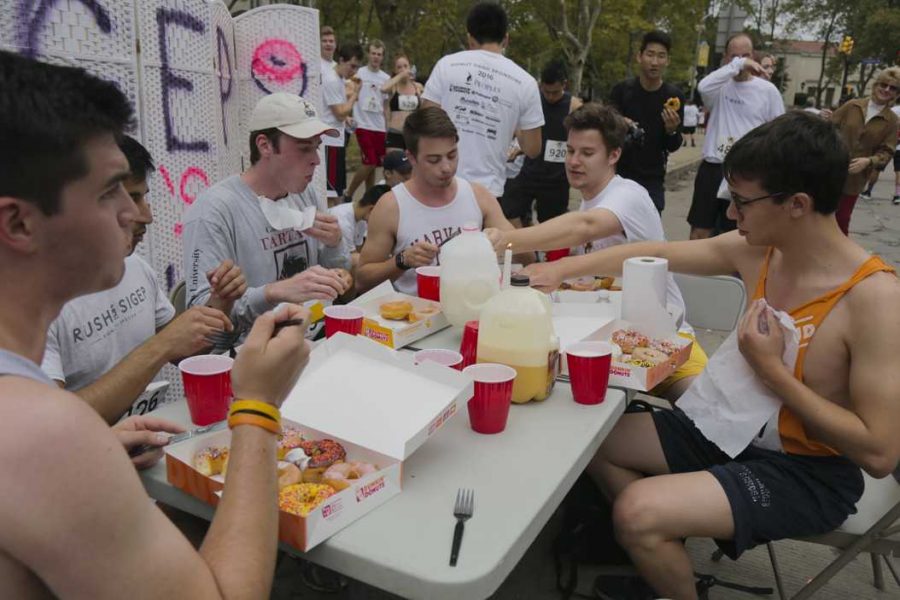Neil Alexander, who was diagnosed with ALS in 2011, died six weeks after he and his wife announced the opening of the Live Like Lou Center for ALS Research at Pitt’s Brain Institute.
Since then, the Center has been promoting quality of life research, examining how ALS affects the nervous system and supporting clinical trials to slow or reverse the progression of the disease.
But the research isn’t cheap.
To raise funds, the Center partnered with Carnegie Mellon University’s Sigma Alpha Epsilon fraternity to host the eighth annual Donut Dash Sunday afternoon. Over 1,000 participants raced — first to finish a box of donuts and then to cross the finish line. The event raised $148,547, according to David Ott and Mike McCaffrey, co-organizers of the Dash and members of CMU’s SAE.
“The Donut Dash represents the best combination of compassion, competition and delicious donuts,” Suzanne Alexander said during the event’s welcome speech.
This year’s Donut Dash was the third time CMU’s SAE fraternity partnered with the Center. For $20, each participant ran a mile, scarfed down a box of six donuts and ran a second mile.
Pitt Chancellor Patrick Gallagher and CMU President Dr. Subra Suresh each bit into donuts to kick off the race. After runners straggled to the finish line with full stomachs, the organizers held a raffle for signed Penguins jerseys.
In a speech after the race, Mayor Bill Peduto retold the story of Lou Gehrig, an American baseball legend who was diagnosed with ALS in 1939. Gehrig was inducted into the Baseball Hall of Fame after retirement, which went against voting rules at the time.
ALS — also known as Lou Gehrig’s disease in honor of the baseball legend — is a progressive neurological disease that usually causes death within two to three years of diagnosis, according to David Lacomis, chief of neuromuscular division and professor of neurology and pathology at the Pitt’s School of Medicine. Lacomis said only about 10 percent of ALS patients survive 10 years after diagnosis.
According to Lacomis, research into the disease has led to discovery of only one drug that increases life expectancy of patients with ALS, but only by about three months.
Since ALS is rare — only 20,000 Americans currently live with the disease, according to the ALS Association — Lacomis said it is necessary to pool resources and develop institutional centers of research excellence, such as the Live Like Lou Center.
“In order to find more effective treatments, much more research will be needed, and government funding has decreased,” Lacomis said. “Therefore, increased public awareness is crucial to attract donations, and fundraising, like the Donut Dash, is crucial in fueling research discovery.”
The Ice Bucket Challenge — a social media campaign that encouraged people to either donate to ALS research or have a bucket of ice water dumped on their heads— raised enough money for researchers to identify a gene unique to ALS patients in July. This discovery sped up diagnosis time and enabled doctors to provide prolonged and improved treatment for ALS patients.
When SAE started the annual Donut Dash in 2009, it donated the funds to the Children’s Hospital of Pittsburgh of UPMC. When the fraternity’s alumni adviser, Bob Dax, was diagnosed with ALS in 2014, the fraternity switched its philanthropic focus to ALS research.
“This was very hard for us as a fraternity. Dax means an incredible deal to our brotherhood,” Ott said. “We asked him what we could do to support him in this difficult time. After some discussion, we decided to direct Donut Dash’s charitable donation to ALS research.”
That year, the fraternity connected and co-hosted the Donut Dash with the Alexander family’s Live Like Lou Patient Care Fund, which raises money for ALS research and supports families suffering from ALS in Pennsylvania. In their first year as partners, the groups raised over $100,000.
To promote the Western Pennsylvania Chapter of the ALS Association, an organization that helps allocate funds raised at Live Like Lou events, events associates Lauren Reinhard and Julia Marsili set up a table to collect donations.
The funds that are not used for research are allocated into two broad categories, one for patient care and the other for scholarships and opportunities for children of ALS patients.
“Everything we get goes back to the patients,” Reinhard said. “We give them everything they need to make their last two to six years comfortable.”
Reinhard said that although there is currently no cure for ALS, increased awareness is helping researchers move toward developing a treatment.
At Pitt, the Brain Institute is working to further this research.
“The first chapter of the ALS Association was founded in Pittsburgh, the first walk for ALS was hosted in Pittsburgh and events like the Donut Dash are making Pittsburgh a hub for ALS research,” Reinhard said. “It’s amazing what Pittsburgh as a whole can do for ALS.”


